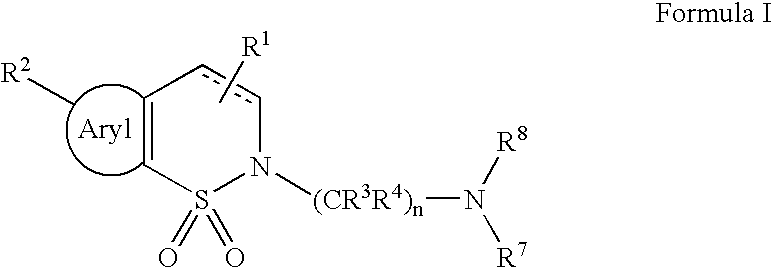Serotonergic 5HT7 receptor compounds for treating ocular and CNS disorders
a receptor and ocular technology, applied in the field of serotonergic 5ht7 receptor compounds for treating ocular and cns disorders, can solve the problem of not being clear which receptor(s)
- Summary
- Abstract
- Description
- Claims
- Application Information
AI Technical Summary
Benefits of technology
Problems solved by technology
Method used
Image
Examples
example 1
6-Chloro-2-[4-[4-(2H-benzimidazo-2-oxo-1-yl)piperidin-1-yl]butyl]-2H-thieno[3,2-e]-1,2-thiazine 1,1-dioxide Hydrochloride
[0045]
Step 1. A solution 6-chloro-3,4-dihydro-2H-thieno[3,2-e]-1,2-thiazine-4-ol 1,1-dioxide (9.0 g, 37.6 mmol) in dimethylformamide (200 mL, anhydrous) and sodium hydride (60% in oil, 1.66 g, 41.5 mmol) was reacted with 1,4-dibromobutane at 0°. The reaction was stirred in an ice bath for 30 min and then it was allowed to warm to room temperature and stir for three days. The mixture was poured into ice water (400 mL) and extracted with diethyl ether (2×200 mL). The combined organic layers were washed with water (200 mL), brine (200 mL) and then were dried over magnesium sulfate and evaporated. The resulting residue was purified by silica gel flash chromatography with hexane / ethyl acetate (7:3) to give 6-chloro-3,4-dihydro-2-(4-bromobutyl)-2H-thieno[3,2-e]-1,2-thiazine-4-ol 1,1-dioxide as a colorless oil (10.62 g, 75%); the 1H NMR was consistent with the structur...
example 2
3-(4-Methylpiperidin-1-yl)propylsulfonyl-2,3-dihydro-1H-indole Hydrochloride
[0054]
Step 1. To a solution of indoline (4.00 g, 33.6 mmol) in 100 mL of acetone at 0° C. was added 3-chloropropanesulfonyl chloride (5.95 g, 33.6 mmol) with stirring. A solid precipitated from the solution. Diisopropylethylamine (4.33 g, 33.6 mmol) was added in two portions and the reaction mixture became a homogenous solution. The mixture was stirred for 30 min, warmed to ambient temperature, and evaporated to dryness. The crude mixture was combined with a saturated aqueous solution of sodium bicarbonate and extracted with ethyl acetate (2×100 mL). Chromatography on silica (10% to 25% ethyl acetate / hexane) gave an oil which solidified on standing (7.68 g, 77%, mp 53-53° C.).
Step 2. A mixture of the product of Step 1 (200 mg, 0.77 mmol) and 0.5 M solution of 4-methylpiperidine (4 mL, 2.0 mmol) was heated at 35° C. for 60 h. The reaction mixture was combined with a saturated aqueous solution of sodium bi...
example 3
N-[3-[4-(3-Chlorophenyl)piperazin-1-yl]propyl]-N-(4-methoxyphenyl)-propanesulfonamide Hydrochloride
[0071]
Step 1. To a solution of p-anisidine (6.00 g, 48.7 mmol) and triethylamine (5.91 g, 58.4 mmol) in methylene chloride (200 mL) at 0° C. was added propylsulfonyl chloride (7.64 g, 53.6 mmol) with stirring under nitrogen atmosphere. The reaction mixture was allowed to warm to room temperature and stirred overnight. The mixture was washed with a saturated aqueous solution of sodium bicarbonate (100 mL), water, and dried over magnesium sulfate. The organic layer was evaporated to give an oil that was mixed with a solution of hexane and ethyl acetate (3:1) to afford a crystalline solid (7.97 g). The mother liquid was chromatographed on silica (hexane / ethyl acetate, 4:1) to give a solid (2.27 g, 92%): mp 72° C.; MS(−ES) 228 (M−H).
Step 2. To the product of Step 1 (3.50 g, 15.3 mmol) in anhydrous dimethylformamide (80 mL) at 0° C. was added sodium hydride (60% suspension in mineral oi...
PUM
 Login to View More
Login to View More Abstract
Description
Claims
Application Information
 Login to View More
Login to View More - R&D
- Intellectual Property
- Life Sciences
- Materials
- Tech Scout
- Unparalleled Data Quality
- Higher Quality Content
- 60% Fewer Hallucinations
Browse by: Latest US Patents, China's latest patents, Technical Efficacy Thesaurus, Application Domain, Technology Topic, Popular Technical Reports.
© 2025 PatSnap. All rights reserved.Legal|Privacy policy|Modern Slavery Act Transparency Statement|Sitemap|About US| Contact US: help@patsnap.com



